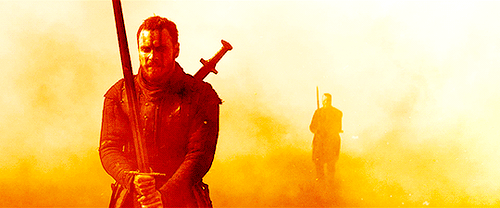

The added importance the film gives to Ross did not appear in the first draft of the screenplay, which instead invented a new character called the Bodyguard, who also serves as the Third Murderer. In Roman Polanski's 1971 film version of Macbeth, the Third Murderer is Ross, played by John Stride. In Marvin Kaye's 1976 book Bullets for Macbeth, a stage director dies without telling anyone which character is the Third Murderer in his production, and detectives attempt to solve the mystery. James Thurber published a humorous story "The Macbeth Murder Mystery" in The New Yorker in 1937, in which the narrator attempts to solve a whodunit claim that Macduff was the Third Murderer. Another proposed solution is that the character is a non-human personification of a concept such as Destiny. Suggestions that the Third Murderer was the Thane of Ross were dismissed by Bertha D. Macbeth appears surprised Fleance has escaped, though the surprise may be feigned. The scene in which the First Murderer describes the killing of Banquo to Macbeth has been used for and against arguments of Macbeth's identity as the Third Murderer. Scholar Henry Norman Hudson also addressed and attempted to refute speculation that Macbeth was the Third Murderer. Addis instead connected the Third Murderer to the spy mentioned by Macbeth in 3.1. John Addis complimented Paton for the "quite original suggestion", citing the belief Macbeth sent the Third Murderer out of "superabundant caution", and acknowledging Macbeth could have sent himself owing to that caution.

Hills also believed the First Murderer was the one who extinguished the light. can be attributed to Shakespeare's lack of attention to detail. Hills interpreted the play as portraying Macbeth, Lady Macbeth and all guests as arriving at the banquet at the same time, rather than Macbeth being late, and the mention of 7 p.m. Paton's theories attracted attention, with Erato Hills of the University of Cambridge calling it "very ingenious", but not supported by the play. (The line is actually "Thou canst not say I did it. Paton believes the Third Murderer extinguished a light to avoid recognition, and later, Macbeth tells Banquo's ghost something that sounds like "In yon black struggle you could never know me". Paton argued the successful killings of Banquo and Fleance were personally important to Macbeth, and that while the banquet that night was scheduled to start at 7 p.m., Macbeth did not appear until midnight. In 1869, author Allan Park Paton advanced the argument that Macbeth personally served as the Third Murderer. In 1929, Professor Theodore Halbert Wilson said the question of who the character is always provoked interested debate among his students. Much of the discussion of the Third Murderer has centred on the character's identity, although the character may only be an extra. Altogether, the Third Murderer has six lines, almost all very brief, with the only long one showing "a suspicious familiarity with Banquo's habits". After the murder of Banquo, the Third Murderer asks "Who did strike out the light?" and concludes Fleance has escaped: "There's but one down the son is fled". The Third Murderer knows Banquo typically walks from the palace gate at this time. He needs not our mistrust, since he delivers Our offices and what we have to do To the direction just. But who did bid thee join with us? Third Murderer. In 3.3, the Three Murderers meet in a park outside of the palace, and the first two do not know the Third: First Murderer.

The first two murderers are recruited by Macbeth in 3.1. Macbeth recruiting the first two murderers, in a 1936 Harlem production of the play


 0 kommentar(er)
0 kommentar(er)
